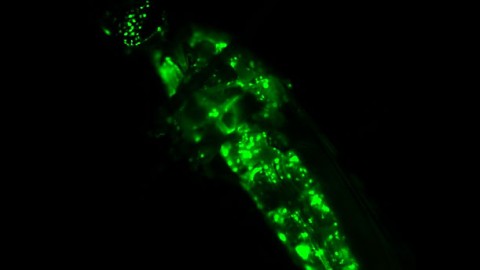On May 5, 2010, the foundation announced the Grand Challenges Explorations Round 4 winners. Seventy-eight scientists were awarded grants for projects focusing on one of four categories. Some of the winners are featured here.

Grant winner Sang-Yeon Cho (left) and his colleague Immo Hansen of New Mexico State University are developing a new diagnostic device that uses microscopic holes ("nanoholes") on gold film to focus light on antibody-antigen reactions. This creates electromagnetic waves, which can then be measured to indicate the presence of malaria parasites.

Keith Dunning of the Millennium Health Microscope Foundation in the United Kingdom is developing a new hand-held, low-cost fluorescent microscope.
Pathogens such as malaria parasites or tuberculosis bacterium become fluorescent at certain wavelengths, allowing easy detection at low magnifications with this palm-sized device.

Roozbeh Ghaffari, and colleagues at Diagnostics For All & MC10 Inc. are developing a disposable paper diagnostics tool embedded with inexpensive optoelectronics. The diagnostics tool will produce a color readout to measure HIV viral load in AIDS patients.

John Aitken of the University of Newcastle in Australia is testing organic compounds, called quinones. These compounds, which react to enzymes in semen, are known for their ability to not only immobilize sperm, but also halt sexually transmitted diseases such as chlamydia.

Michael Skinner of Washington State University in the U.S. is testing the ability of a compound to impair the functioning of the Sertoli cell. The Sertoli cell enables the production and maturation of sperm. Better understanding how this compound works could lead to the development of a new male contraceptive pill.

Youngnim Choi of Seoul National University in Korea is studying whether a common bacteria often found in human mouths can be used to deliver vaccines under the tongue. This bacteria has the ability to invade surface cells, providing a vehicle to introduce vaccines directly to mucosal immune cells in the mouth.

Rong Fan of Yale University in the U.S. is developing a microchip to assess the functioning of thousands of single T cells at one time. This new technology could be used to evaluate T cells from patients in HIV vaccine trials.

The genomes of filarial parasitic worms are riddled with genes from the bacteria Wolbachia, which live in the cells of various invertebrate species. Julie Dunning-Hotopp of University of Maryland in the U.S. is investigating whether targeting those bacterial genes with drug therapies can kill the parasitic worms and treat neglected tropical diseases such as lymphatic filariasis and river blindness. Photo credit: Kerstin Fischer, Washington University School of Medicine.

The Anopheles mosquitoes that transmit malaria easily evolve resistance to insecticidal agents, hampering control efforts. Jason Rasgon of the Johns Hopkins Malaria Research Institute in the U.S. is creating a virus to specifically kill old mosquitoes. Infected mosquitoes will live long enough to reproduce, slowing or halting resistance evolution, but will not live long enough to transmit malaria.

Kathleen Sienko of the University of Michigan in the U.S. has developed a circumcision tool for use in traditional ceremonies in Africa. She is testing its functionality, cultural suitability, and potential for low-cost mass production in hopes that the tool will increase circumcision rates and lower HIV transmission in the region.

David Sintasath of Malaria Consortium in Thailand will provide migrant workers along the Thai-Cambodia border with traditional scarves called krmas, which have been pretreated with insecticides.
Kramas are often used for everything from face masks and baby slings to nighttime blankets. Sintasath will then monitor subsequent rates of drug-resistant malaria to determine if the treated scarves help reduce infection rates in this mobile population.